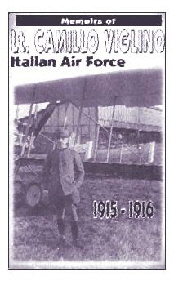


Golden Eagle
First License Wings
|
A Selection From
The Memoirs of Lt. Camillo Viglino, Italian Air Force
Translated by his two children
Camilla Viglino Hurwitz and
Victor Viglino
|
The full course for becoming a pilot during the war consisted of two parts. First we had to obtain the First License, which bestowed on us the title of Cadet Pilot Aviator. . .
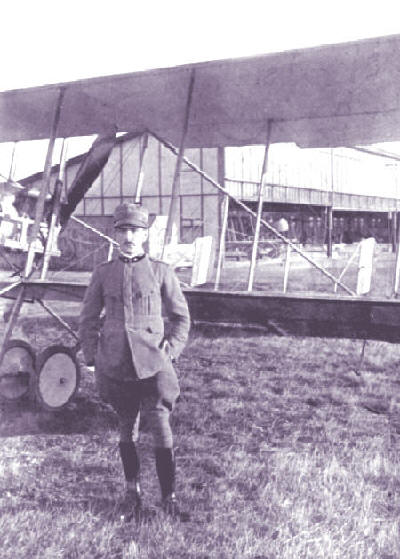
The Author During Training, 1915
MALPENSA AIR FIELD
I began my training for the First License at the Malpensa Field near Somma Lombardo toward the end of July, 1915. At that time, heroics were an everyday part of aviation. That's why everyone stared in awe at the insignia of Golden Eagles imbedded on the shirt sleeve of those who had completed their First License. And just to make sure it was visible, it wasn't unusual to see a young pilot walking with his coat over his arm in the dead of winter. The risk of getting pneumonia seemed like a small price to pay for the admiration gained by the insignia. The pilot who succeeded in flying his plane over his own home town was written up in the local newspaper. In fact, every once in a while, a plane would disappear from the field for a time followed by an excited telephone call from the police of someone's home town thirty miles away informing us that the plane had been spotted overhead.
While we were working on our First License, we were called 'Aspiring Pilot Aviators" and were given a metal propeller to wear on our hats. But of course, no "hazardous duty" pay to accompany it. To top it off, we had to contribute regularly to the purchase of funeral wreaths for our classmates killed in the training course. Once we completed the First License, we did receive a hazardous duty pay of about four liras per day. And after we completed the Second License, we received an additional hazardous duty pay of about three liras per day.
In those days only men from the engineering, artillery, and cavalry units were permitted to volunteer for pilot training. Ordinary infantrymen were not. Pilot trainees, such as myself, who generally came from upper class families, had therefore willingly left a relatively safe environment for one full of risk - the term "risk of luxury" was the way it was sometimes described.
At Malpensa, we flew the Maurice Farman, Model 1912 planes. The Model 1912 had the cockpit in front of the wings and the steering board, or as we called it, the stabilizer, in front of the cockpit. The plane was so easy to fly that in honor of the inventor, we named it 'Maurizio: It will kill you only if you have a death wish". We also called it "Father of the Family".
Within a 100 square mile area of flat marshland there were four aviation fields - Busto Arsizio, Malpensa, and Cascina Costa for training the pilots, and Vizzola for testing the Caproni planes. The sky was therefore always full of airplanes crossing over and under each other in every which way. When the big Caproni bomber planes went by, the Farmans veered off and gave them the right of way out of respect.
At Malpensa there was a single road which, starting at the barracks, circled the field. Because it was the only road wide enough to accommodate the planes, it was also used as the runway and planes all lined up along it in preparation for take-off. Each plane was assigned to an instructor and a group of students. One by one they flew a few feet above the ground, ascending and descending in turn making very sure to stay on the road. The importance of staying on the road was to teach us precision landing and to avoid the damage to the plane and ourselves that could result from veering off the road. If you did veer off the road, you were suspended from flying for a day without flight pay.
First in line - farthest from the barracks - were the students who were making their first flight alongside an instructor. It was standard practice for the survivors of the "flight of terror" to pay for drinks all around immediately afterwards. First the student would fly as a passenger for about five minutes just to see if he could hack it. Often, he came back without having seen or understood anything because his goggles were never properly adjusted and the wind was so strong that he had to keep his eyes shut most of the time. If the first trip indicated that the student had what it took to fly, the training started. He and the instructor boarded a plane with dual controls. The instructor sat in front and handled the set of controls which could override those in the rear being used by the student. The student learned by imitating the actions of the instructor. The aviation lingo between them was full of idiomatic expressions created earlier by French pilots. These expressions included taxi, take off, climb, dive, glide, and land. Let's hope this foreign lingo will soon disappear.
When the instructor felt that the student was ready, he let him switch to the front controls and he would sit in the back correcting any mistakes the student was making. The controls were actually very intuitive and easily learned. A single lever was used for all directions. You pulled it towards you to climb, pushed it away from you to descend, tilted it left to roll to the left, and tilted it right to roll to the right. To conduct a full turn left or right, you simply stepped on the left or right pedal.
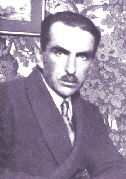
The Author
After the War |
Unfortunately, not everything was easy. For example, it wasn't so easy to maintain the dynamic equilibrium of the plane, and without equilibrium, you quickly found yourself spiraling downwards like a falling leaf. Nor was it easy to determine from up high how to maneuver the plane so that you could land in a specific location. It wasn't so easy to land the plane upright at just the right time - a little too late and you slammed into the ground; a little too soon and the plane dropped downward from its own weight. In other words, you had to straighten the plane just as you touched the ground and at just the right speed to avoid nosing down or yawing. With all these problems, it wasn't at all unusual for us to end up slamming against houses or trees particularly if the landing area was unsuitable, which it often was.
SHORT RUN
After about twenty flights with the instructor, each lasting from five to ten minutes, we went on to the next exercise, called "taxiing". For taxiing we were alone in the plane and we stayed on the ground. The purpose of the exercise was to learn how to take off without yawing. If you weaved just a little, the plane could easily start to spin around itself and, at those take-off speeds, the carriage of the plane would detach and the plane would fall on its side, smashing against the ground.
Next we went on to the third exercise called the "Short Run". In the Short Run the student really flew alone for the first time. In this exercise, the student had to fly for a distance of about 300 feet, at about nine to twelve feet above the ground, and land. A classmate helped him turn the plane around at the end of each lap. On an average, a student would make anywhere from two to four Short Runs per day.
In the first few laps, the minimum damage was likely to be the breaking of the tension wires. There was one mechanic who was particularly good at repairing them and he would charge the students two cents per wire. From the sidelines the students urged him to hurry up complaining that they were wasting time that they wanted to spend making Short Runs.
What happened one day will help the reader understand the intensity of the mania which I had for flying. A burning plane fell quite close to me while I was in the process of practicing my Short Runs. Everyone else ran toward the plane. I, however, saw it as an opportunity to make more Short Runs than I would normally be able to make. Because even the classmate assigned to help me turn the plane around had run toward the burning plane, it took some heroic strength to turn the plane around by myself. Finally, I felt guilty for making Short Runs while others may have been dying - in fact, two men in the plane had been burned to death - and belatedly ran toward the wrecked plane.
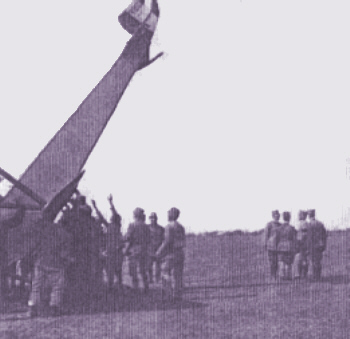
A Student Crash
The constant occurrence of disasters, and the knowledge that they could happen to you at any moment, left you feeling indifferent to the fate of others. When someone died or was injured, the authorities immediately removed him and quickly made us fly again so that we wouldn't have time to mull over the dangers.
On that particular evening, we all went to a small restaurant that we frequented often and ordered steak. Someone in our group noticed that the smell of the steaks resembled that of the charred bodies of the two men and he said so out loud. The rest of us just continued to eat our steak without comment. Today it happens to you; tomorrow it happens to me. It's all part of the game.
But don't think for a minute that we didn't have respect for our classmates killed in flight. When the field truck passed in front of the cemetery, we all saluted. And when we passed over the cemetery in flight, again we all saluted. We were saluting the friends that we could be joining at any moment. When we attended the funeral of our friends who died flying, the women would look at us all with eyes full of pity. But we were no more deserving of their pity than the infantrymen who died hungry, in dirty trenches filled with lice. I guess in contrast to them, we risked a cold death, often foreseen, all alone, without the excitement of the hand-to-hand combat to distract us from its approach.
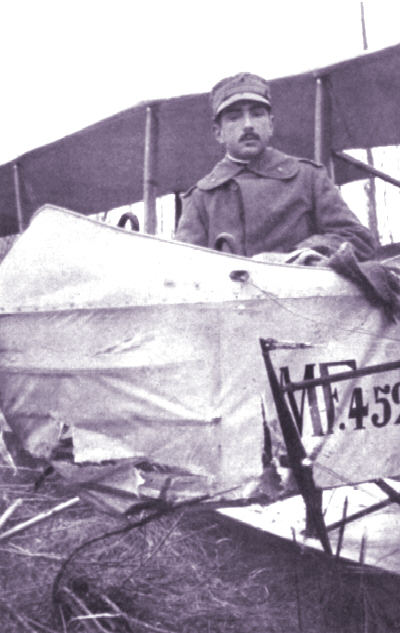
The Author in a Damaged Maurice Farnam
After His Own Near-Fatal AccidentLONG RUN
The Short Run taught us how to maintain a straight flight path and how to land. Next, we began practicing our fourth exercise, the "Long run". On the Long Run, we flew about 150 feet above the ground for a distance of about 1.5 miles. The Long Run made landing more difficult because at the higher altitude, we had to begin to deal with air turbulence. Standing on the ground, you can't imagine the vertical air currents which rise (updrafts) and descend (downdrafts) constantly even when the air is relatively calm. The ground, heated by the sun, warms the air immediately above it which, being lighter, rises in vertical currents. Simultaneously, the warm, lighter air is replaced by colder air in descending currents. The airplane is caught in the middle of these two opposing currents. Under these conditions, a very strong, stiff wind coming head-on can literally stop the plane. (This happened to me during my training for the Second License. I will give the details of this adventure later on in the book). To avoid the most violent air currents, in the summer the students didn't fly from 10 am to 4 pm, the hottest part of the day.
Those student pilots who unexpectedly found themselves in the middle of air currents without having been forewarned, could become petrified. While I was attending the funeral of someone in our air field, I met up with Ruggerone, who had made the first flight around the Cathedral of Milano in 1910. He told me that prior to his first encounter with air currents, he had flown only in the winter in the mountains. He encountered air currents for the first time while flying over a relatively large town where the roof tiles produced large air currents. This first taste of air currents scared him so much that he could do nothing but recite every prayer that he could think of, keeping his eyes on the locket of the Madonna around his neck, as if to say, "Help me". He ended up overcoming his fear and surviving the flight. But then, if only those without fear flew, no one would fly. When you got a good handle on them, air currents could be lived with, and talking about our experiences with them was a great pass-time. What took us off guard was encountering them by surprise. Thank God that nowadays students are forewarned of them by their instructors.
TOUR OF THE FIELD
Having mastered the Long Run, we began our fifth exercise, called the Tour of the Field. We would circle around the entire field, both clockwise and counter clockwise, just to get used to going both ways. At the end of the flight, we would be at an altitude of about 600 to 900 feet and we would try to land at our point of departure by throttling down the engine and gliding down in a straight line with the wings level. After we learned how to make a straight glide, we had to learn how to make descending turns. First a quarter turn to the left and to the right, then a half turn - also called a "one-eighty", then a complete turn - called a "three-sixty.
I was still working on my Tours of the Field and trying to master the landing with a straight glide, when I was ordered, by mistake, to make the "Half Hour Flight" which normally came much later in our training. In the Half Hour Flight the pilot climbed to about 3,600 to 4,500 feet and went farther from the field. I'll describe the Half Hour Flight in more detail in another section. Anyway, instead of calling attention to the fact that I wasn't really trained for the Half Hour Flight, I snatched the opportunity to go on it. I guess the outcome was predictable. I found myself unable to bring the plane down because landing with a straight glide from that altitude required experience, and I had not yet mastered descending with turns. I could have glided straight down to about 600 feet, throttled up the engine to bring the plane closer to my landing destination and then glided straight to Malpensa from the lower altitude - but that would have been too humiliating. I remembered having heard that from 3000 feet above the Oleggio Bridge it was possible to make a straight glide all the way to Malpensa. I therefore went to the Oleggio Bridge and started the glide. Unfortunately, I mistook the hangars at Vizzola, which were close, for those at Malpensa and made such a steep glide that my ears were ringing from the speed of the descent. Finally, I landed at Vizzola and from there flew on to Malpensa.
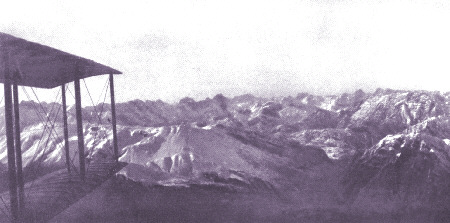
Flying in Sight of the Alps
What an emotional experience that flight was. It was the first time that I had climbed to such an altitude. The month was September and it was sundown. I found myself in the middle of an immense cylinder of light, white and golden higher up, and darker lower down until it became violet. Above me was the clearest blue sky. In front of me, far away, the massif Monte Rosa, solemn and joyful, like a huge, friendly giant. Closer to me on the right, resembling an emerald goblet, was Lake Maggiore, and my home town, Intra. It was so beautiful that it brought tears to my eyes and evoked in me a sudden urge to praise God.
After that memorable flight, I got into the habit of reciting my morning prayers on the plane. I enjoyed them more that way. In the future, when flying becomes more routine, it should be possible to celebrate mass on it. After all, where can you find a church more beautiful than the sky? . . .
To continue reading the adventures of Lt. Camillo Viglino, order his complete memoirs at Trafford Publishing:
Website: www.trafford.com/robots/01-0335.html
Toll Free: 1-888-232-4444
|
|
|
Sources and thanks:
Selection presented by permission of Camilla Viglino Hurwitz and Trafford Publishing. This book was written in Italian and originally published as Venite a Volare Con Me in 1934 by Societa Editrice Internazionale. It was translated into English by his two children, Camilla Viglino Hurwitz and Victor Viglino.
|

|









